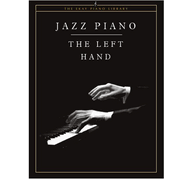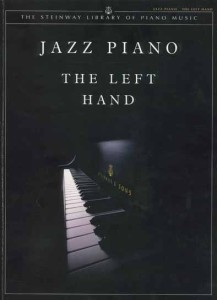Jazz Piano: Left Hand Techniques
One of my most beloved and successful books is my method Jazz Piano: The Left Hand, published by Ekay Music (Bedford Hills, New York) in 2005 as part of the prestigious Steinway Piano Library of Piano Music (then reprinted in 2010 as part of the outstanding Ekay Piano Library), easily available through music dealers and online through Amazon, Alfred Music Publishing, etc. This book offers 257 pages featuring about 500 musical examples, most of them 8-bar, 12-bar or 16-bar long (or even longer). Below here are some audio samples: a “tumbao” bass figure applied to the beginning of Groovin’ High (page 218):
a boogie-woogie chorus on a Dick Hyman‘s bass figure (p. 110):
an application of Bud Powell’s “harmonic fragmentation” (also with syncopated low notes) to the changes of Autumn Leaves, section A (p. 148):
an application of Michel Camilo’s “salsa stride” bass to Beautiful Love (not printed in complete in this book, yet published in complete in “Piano Today” magazine):
a basic stride bass used in section A of Just One Of Those Things (p. 3):
a stride bass with “back beats” applied to the bridge of Dinah (p. 30):
Cliff Jackson’s “walking stride bass” with “back beats” applied to the changes of Honeysuckle Rose, section A (p. 35):
a “countertime syncopation” of the basic stride bass (p. 42):
a typical Swing-style “three-handed” effect applied to section A of Moonglow (p. 124):
a simple application of Art Tatum’s syncopated “ostinato” octave skips to the opening changes of Night And Day (pp. 137-138):
a tumbao-like bass pedal point with broken octaves from the D section of my piece Mi Ritmo (p. 216):
some applications of the well-known “walking bass” technique when stating a theme (C Jam Blues, p. 169), then along with a right hand improvisation (on the changes of Summertime, pp. 169-170), then along with right hand chords when comping (on section B of Autumn Leaves, pp. 170-171):
the opening of a blues chorus featuring Donald Lambert’s “12ths and beyond” contrapuntal bass (p. 24, adapted from my piece Quiet Blues in my collection Southern-Fried Blues, San Diego, CA, Neil A. Kjos Music Company):
a blues chorus on a Junior Mance’s jazz-waltz bass pattern (p. 194):
a blues/boogie chorus on Luckey Roberts’s “anticipated and filled-in broken octaves” (p. 17):
and finally a bluesy drill on the exciting Johnny Guarnieri’s “syncopated 5/4 swing bass” (p. 181):
Covering a span of time and styles ranging from jazz beginnings to some of the most recent developments, this book collects and analyzes many of the most frequently used jazz, blues, boogie-woogie, Latin, and Latin jazz left-hand piano techniques. Generally, each proposed technique is first introduced by a “model” figure transcribed or derived from original sources, followed by an explanation of its pattern, and finally by some sample applications using well-known songs, harmonic progressions, or original pieces. For the sake of completeness, most of these left-hand applications are integrated with sample right-hand parts that validate the efficacy and concrete application of the left hand figures. In this book you will find the specific techniques used by most of the major jazz, blues and Latin piano masters, such as Eubie Blake, Jelly Roll Morton, James P. Johnson, Willie “The Lion” Smith, Fats Waller, George Gershwin, Jimmy Yancey, Meade Lux Lewis, Earl Hines, Art Tatum, Teddy Wilson, Erroll Garner, Thelonious Monk, Bud Powell, George Shearing, Red Garland, Dick Wellstood, Dick Hyman, Dave McKenna, Dave Brubeck, Oscar Peterson, Bill Evans, McCoy Tyner, Chick Corea, Keith Jarrett, Ernesto Lecuona, Eddie Palmieri, Santos Chillemi, Michel Camilo, etc. Therefore, this book can also be seen as an essay and historical guide on most of jazz piano styles and developments. Also covered are several peculiar techniques devised by some lesser known yet outstanding figures such as Luckey Roberts, Donald Lambert, Cliff Jackson, Bob Zurke, Johnny Guarnieri, James Booker, etc. Some chapters on voicings, ostinatos, and jazz waltz stylings are included too.
I wish to thank my publisher Edward J. Shanaphy, President of Ekay Music, who gave me the idea for this book and made it a dream come true, also introducing it as follows: <<[…] Riccardo Scivales, […] one of the foremost authorithies on traditional jazz piano playing we know […] has recently completed a new book just now going to press, Jazz Piano: The Left Hand. This is an extraordinary treatise that traces, demonstrates, and puts into practice the techniques of the left hand in popular and jazz piano styles from ragtime to the present day. The age-old complaint, “I don’t know what to do with my left hand,” has plenty of sure-fire remedies lurking within the pages of this major work.>> (Ed Shanaphy, People of Importance, “Sheet Music Magazine”, Summer 2005).
This book has got very favourable reviews, and I hope you will enjoy the audio samples featured here! 
TESTO IN ITALIANO: Uno dei miei libri preferiti e di maggior successo è il mio metodo Jazz Piano: The Left Hand, pubblicato nel 2005 da Ekay Music (Bedford Hills, New York) nella prestigiosa collana The Steinway Piano Library of Piano Music e ristampato nel 2010 come parte della serie The Ekay Piano Library. Facilmente disponibile presso i rivenditori di musica e online attraverso Amazon, Alfred Music Publishing, ecc., questo libro offre 257 pagine con circa 500 esempi musicali, la maggior parte dei quali lunghi 8, 12, o 16 battute (o anche più). Qui di seguito, eccone alcuni esempi audio: un basso “tumbao“ applicato all’inizio di Groovin ‘ High (pagina 218): 00:0000:00 un chorus boogie-woogie su una figura di basso di Dick Hyman (p. 110): 00:0000:00 un’applicazione della cosiddetta “harmonic fragmentation” di Bud Powell (anche con note basse sincopate) sul giro armonico di Autumn Leaves, sezione A (p. 148): 00:0000:00 un’applicazione del fantastico basso “salsa stride” di Michel Camilo a Beautiful Love (esempio stampato parzialmente in questo libro, ma pubblicato in completo nella rivista “Piano Today” ): 00:0000:00 un “Basic stride bass” nella sezione A di Just One Of Those Things (p. 3): 00:0000:00 un “Basic stride bass” con “back beats” applicato al bridge di Dinah (p. 30): 00:0000:00 il trascinante “Walking stride bass con back beats di Cliff Jackson”, sugli accordi di Honeysuckle Rose, sezione A (p. 35): 00:0000:00 una “sincopazione in controtempo del Basic stride bass” (pag. 42): 00:0000:00 un tipico stilema del pianismo Swing con effetto “a tre mani”, sulla sezione A di Moonglow (p. 124): 00:0000:00 una semplice applicazione della tecnica Swing ‘”ostinato con salti d’ottava sincopati” usata da Art Tatum ecc. , sugli accordi iniziali di Night And Day (pp. 137-138): 00:0000:00 un “bass pedal point a ottave spezzate su pattern tumbao”, dalla sezione D del mio brano Mi Ritmo (p. 216): 00:0000:00 alcune applicazioni della nota tecnica “walking bass” all’esposizione di un tema (C Jam Blues, pag. 169), poi insieme a un’improvvisazione della mano destra (sugli accordi di Summertime, pp 169-170), poi con accordi della mano destra in una situazione di comping (nella sezione B di Autumn Leaves, pp 170-171): 00:0000:00 l’inizio di un chorus blues basato sul “basso contrappuntistico di Donald Lambert con salti di dodicesima (e oltre)” (p. 24, adattato dal mio brano Quiet Blues, dalla mia collezione Southern Fried-Blues, San Diego, CA, Neil A. Kjos Music Company): 00:0000:00 un chorus blues su un pattern di basso “jazz-waltz” di Junior Mance (p. 194): 00:0000:00 un chorus blues/boogie alla Luckey Roberts, con “basso anticipato a ottave spezzate e con note di riempitivo” (p. 17): 00:0000:00 e infine, un esercizio bluesy sul trascinante “basso Swing sincopato in 5/4” di Johnny Guarnieri (p. 181): 00:0000:00 Coprendo un arco di tempo e di stili che vanno dagli inizi del jazz ad alcuni dei suoi più recenti sviluppi, questo libro raccoglie e analizza molte delle tecniche per la mano sinistra più frequentemente utilizzate nel jazz, il blues, il boogie-woogie, la musica latinoamericana e il Latin Jazz. Generalmente, ogni tecnica proposta è introdotta da una figura “modello” trascritta o desunta da fonti originali, poi seguita da una spiegazione del suo pattern, e infine da vari esempi applicati a famose canzoni e progressioni armoniche, o a brani originali. Per ragioni di completezza, la maggior parte di queste applicazioni sono integrate da parti complete della mano destra, che convalidano l’efficacia e la concreta applicazione delle figure della mano sinistra. In questo metodo sono trattate le tecniche specifiche utilizzate dalla maggior parte dei più grandi maestri del piano jazz, blues e Latin, come Eubie Blake, Jelly Roll Morton, James P. Johnson, Willie “The Lion” Smith, Fats Waller, George Gershwin, Jimmy Yancey, Meade Lux Lewis, Earl Hines, Art Tatum, Teddy Wilson, Erroll Garner, Thelonious Monk, Bud Powell, George Shearing, Red Garland, Dick Wellstood, Dick Hyman, Dave McKenna, Dave Brubeck, Oscar Peterson, Bill Evans, McCoy Tyner, Chick Corea, Keith Jarrett, Ernesto Lecuona, Eddie Palmieri, Santos Chillemi, Michel Camilo, ecc. Pertanto, questo libro può anche essere visto come un saggio e una guida storica sulla maggior parte degli stili di pianoforte jazz e i suoi sviluppi. Inoltre, sono qui descritte numerose tecniche particolari ideate da vari maestri meno noti, ma assolutamente straordinari (come Luckey Roberts, Donald Lambert, Cliff Jackson, Bob Zurke, Johnny Guarnieri, James Booker, ecc.), e sono inclusi anche alcuni capitoli sui voicings, gli ostinato, e i molti stilemi di “jazz waltz”.
Ringrazio il mio editore Edward J. Shanaphy, Presidente della Ekay Music, che mi ha dato l’idea per questo metodo, lo ha fatto diventare realtà e lo ha presentato così ai lettori di Sheet Music Magazine: <<[…] Riccardo Scivales, […] one of the foremost authorithies on traditional jazz piano playing we know […] has recently completed a new book just now going to press, Jazz Piano: The Left Hand. This is an extraordinary treatise that traces, demonstrates, and puts into practice the techniques of the left hand in popular and jazz piano styles from ragtime to the present day. The age-old complaint, “I don’t know what to do with my left hand,” has plenty of sure-fire remedies lurking within the pages of this major work.>> (Ed Shanaphy, People of Importance, “Sheet Music Magazine”, Summer 2005).
Questo libro ha ricevuto recensioni molto favorevoli, e spero vi piacciano gli esempi audio riportati nel testo in inglese qui sopra!







5 commenti
Pingback:
chris sabbey
Hello,
I really enjoyed your arrangement of Summertime played by MarkPorter on youtube (walking bassline version). Could you please let me know if it’s possible for me to obtain a copy of the sheet music?
Thank you,
Chris
Riccardo Scivales
Hello Chris, many thanks for writing (and I apologize for not responding sooner–I had a chance to see your message just now. many thanks for writing). Yes, you can get a copy of the sheet music of my “Summertime” for just 7 euros, payable through PayPal. Please let me know if this might interest you by writing to: riccardo.scivales@gmail.com It is easier for me to correspond from there! Thank you!
james
Hi Riccardo, I bought your book many years ago. I would like a demonstration of the walking tenth of Teddy Wilson and how to create a line like this.
Thank you
Riccardo Scivales
Hello Chris, many thanks for writing (and I apologize for not responding sooner–I had a chance to see your message just now. many thanks for writing). Yes, you can get a copy of the sheet music of my “Summertime” for just 7 euros, payable through PayPal. Please let me know if this might interest you by writing to: riccardo.scivales@gmail.com It is easier for me to correspond from there! Thank you!